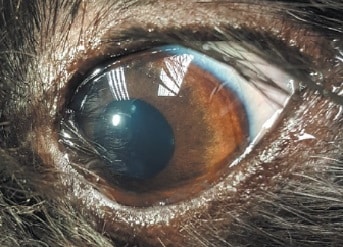Abnormal Eyelashes
One of the most common causes of canine ocular disease is the presence of abnormal eyelashes, which rub on the eye surface causing discomfort and irritation. They can affect one or both eyes and are often seen early in life. Cats are less commonly affected.
- Clinical signs of eyelash disorders depend on the severity and include:
- Increased blinking rate (blepharospasm)
- Rubbing at the eye, holding the eye closed or general irritation
- Increased tear production (epiphora)
- Red eyes (conjunctival hyperaemia)
- Corneal ulcers – these are usually seen with ectopic cilia
Distichiasis
Distichia are abnormal eyelashes which grow from the meibomian glands (multiple glands along the rim of the eyelids) and rub on the eye surface causing discomfort. They can be an incidental finding in older dogs requiring only lubrication, but if present in large numbers they can cause significant discomfort. It is not advisable to breed from dogs with severe distichiasis.
Although any breed or crossbreed can be affected, the disease is most severe in Flatcoated Retrievers, English Bulldogs, Cocker Spaniels, Toy/Miniature Poodles, and miniature long haired Dachshund. Both eyes are usually affected, although one eye may be more severely affected.
- Treatment options include:
- Conservative therapy (plucking, lubrication)• Electroepilation
- Cryotherapy
- Surgical resection
Plucking the hairs reduces the discomfort, but they will regrow over the next few weeks. A more permanent solution involves freezing or electrolysis to prevent hair regrowth. We can only treat the roots of hairs that are visible at the time of surgery, so further hairs can emerge from the untreated glands, meaning that more than one procedure may be required. In some cases we will surgically resect the hairs and their roots.
Ectopic Cilia
Ectopic cilia are abnormal lashes which grow from the same meibomian glands along the eyelid margin, but which grow through the conjunctiva lining the lid to scratch the eye surface directly. They are difficult to find and often require the use of specialist equipment to locate them, especially if they are not coloured hairs. They cause more severe painful disease than distichia and usually result in deep corneal ulcers in one or both eyes.
Commonly affected breeds include English Bulldogs, Pekingese, Shetland Sheepdogs, Flatcoated retrievers and Shih Tzus, although any breed or crossbreed can be affected. The condition is usually diagnosed in young animals.
Treatment of ectopic cilia involves surgical removal of the hair and its root under general anaesthesia and high magnification. If ulceration is present and severe, a corneal/conjunctival graft may also be required. Only one treatment is usually required.
Trichiasis
These are normal but misdirected hairs which rub on the eye surface. Although it can be caused by entropion (inward rolling of the eyelids) and prominent nasal folds, it can be present without these conditions. Removal of the hairs via surgery or cryosurgery resolves these problems, although topical lubrication helps in the short term.
